Life Cycle Assessment of Medical Waste Management: Case Study for Istanbul
Abstract
1. Introduction
- Domestic waste: general waste and packaging waste.
- Medical waste: infectious waste, pathological waste, and sharp-edged waste.
- Hazardous waste.
- Radioactive waste.
2. Materials and Methods
2.1. Case Study
2.2. Life Cycle Assessment
2.2.1. Goal and Scope Definition
2.2.2. Inventory Analysis
- Of the waste collected in İstanbul, 63% is from the European side, whereas the ratio of waste collected on the Asian side is 37%.
- Waste collected from healthcare facilities in İstanbul is mainly classified into two categories: (i) municipal solid waste (non-hazardous) and (ii) medical waste (hazardous).
- Waste generated is collected by İSTAÇ’s licensed trucks and disposed of at the Odayeri and Kömürcüoda Plants on the European side and Asian side, respectively.
- Non-hazardous municipal solid wastes are directly sent to the landfill sites.
- Medical waste is defined as infectious, pathological, and sharp waste from healthcare facilities in Annex 2 to the Regulation on the Control of Medical Wastes. Waste collected from healthcare facilities is classified into 4 main categories: (i) non-hazardous municipal solid waste, (ii) medical waste, (iii) hazardous waste, and (iv) radioactive waste [14]. Each waste category is collected in a different-colored waste bag as determined by the relevant regulation. Furthermore, it is forbidden to open waste bags collected from healthcare facilities according to the Regulation on the Control of Medical Wastes. Therefore, waste characterization could not be conducted in this study. Furthermore, 38% of medical waste is incinerated while the remaining, non-hazardous municipal solid waste is disposed of through sterilization in the current situation.
- Scenario 0, the baseline scenario, represents the current medical waste management system in Istanbul.
- Waste transportation was assumed to operate in a one-way direction, and the return was not considered. Average distances between the waste generation points and waste disposal sites were determined as follows: (i) the transportation distance of waste generated on the Asian side to the Kömürcüoda landfill site is 25.2 km; (ii) the transportation distance of waste collected from the European side to the Odayeri landfill site is 38.2 km; and (iii) the transportation distance of waste generated on both the Asian side and European side to the Odayeri incineration and sterilization facilities is 44.2 km.
- “Truck, diesel driven, Euro 0–5 mix, 7.5 t gross weight/3.3 t payload capacity” data in the GaBi database were used to calculate the fuel consumption of trucks during waste transportation and the emissions.
2.2.3. Impact Assessment and Interpretation
2.2.4. Waste Management Scenarios
3. Results and Discussion
3.1. Global Warming Potential
3.2. Acidification Potential
3.3. Eutrophication Potential
3.4. Ozone Layer Depletion Potential
3.5. Freshwater Aquatic Toxicity Potential
3.6. Human Health Toxicity Potential
4. Conclusions
Author Contributions
Funding
Data Availability Statement
Conflicts of Interest
Abbreviations
| LCA | Life Cycle Assessment |
| İSTAÇ | Istanbul Environmental Management Industry and Trade Inc. (İSTAÇ) |
| İBB | İstanbul Metropolitan Municipality |
References
- Çelik, S.; Peker, İ.; Gök-Kısa, A.C.; Büyüközkan, G. Multi-criteria evaluation of medical waste management process under intuitionistic fuzzy environment: A case study on hospitals in Turkey. Socioecon. Plann Sci. 2023, 86, 101499. [Google Scholar] [CrossRef] [PubMed]
- Omoleke, S.A.; Usman, N.; Kanmodi, K.K.; Ashiru, M.M. Medical waste management at the primary healthcare centres in a north western Nigerian State: Findings from a low-resource setting. Public Health Pract. 2021, 2, 100092. [Google Scholar] [CrossRef] [PubMed]
- Joneghani, N.M.; Zarrinpoor, N.; Eghtesadifard, M. A mathematical model for designing a network of sustainable medical waste management under uncertainty. Comput. Ind. Eng. 2022, 171, 108372. [Google Scholar] [CrossRef]
- Harris, P.; McCabe, B.K. Technical evaluation of steam sterilisation coupled with gasification to improve circularity of Australian hospital waste management: A case study. Resour. Conserv. Recycl. 2024, 207, 107680. [Google Scholar] [CrossRef]
- World Health Organization. Health-Care Waste. 2018. Available online: https://www.who.int/news-room/fact-sheets/detail/health-care-waste (accessed on 12 August 2024).
- United Nations. Our Growing Population. 2022. Available online: https://www.un.org/en/global-issues/population#:~:text=Our%20growing%20population&text=The%20world’s%20population%20is%20expected,billion%20in%20the%20mid%2D2080s (accessed on 12 August 2024).
- Alighardashi, M.; Mousavi, S.A.; Almasi, A.; Mohammadi, P. Development of a decision support tool for choosing the optimal medical waste management scenario using waste flow analysis and life cycle cost. Results Eng. 2024, 22, 102185. [Google Scholar] [CrossRef]
- Balci, E.; Balci, S.; Sofuoglu, A. Multi-purpose reverse logistics network design for medical waste management in a megacity: Istanbul, Turkey. Environ. Syst. Decis. 2022, 42, 372–387. [Google Scholar] [CrossRef] [PubMed]
- United Nations Environment Programme. Waste Management During the COVID-19 Pandemic from Response to Recovery Title: Waste Management During the COVID-19 Pandemic from Response to Recovery. 2020. Available online: https://www.unep.org/resources/report/waste-management-during-covid-19-pandemic-response-recovery (accessed on 8 January 2025).
- Türkiye İstatistik Kurumu. Adrese Dayalı Nüfus Kayıt Sistemi Sonuçları; Türkiye İstatistik Kurumu: Ankara, Türkiye, 2022.
- T.C. Çevre Şehircilik ve İklim Değişikliği Bakanlığı. 2022 Yılı Tıbbi Atık Bülteni; T.C. Çevre Şehircilik ve İklim Değişikliği Bakanlığı: Ankara, Türkiye, 2023.
- Rahmani, M.Z.; Ekmen Özçelik, S. Waste Management Applications in Turkey. Ekon. Yaklasim 2024, 35, 147. [Google Scholar] [CrossRef]
- Republic of Turkey Ministry of Environment and Urbanization. Ulusal Atik Yönetimi ve Eylem Plani 2023; Republic of Turkey Ministry of Environment and Urbanization: Ankara, Türkiye, 2016.
- Republic of Türkiye Ministry of Environment and Urbanization. Regulation on Control of Medical Waste. Official Gazette. Available online: https://www.mevzuat.gov.tr/mevzuat?MevzuatNo=23273&MevzuatTur=7&MevzuatTertip=5 (accessed on 25 January 2017).
- Inskeep, J.; Pashouwer, J.; Peige, K.; Watson, M. Phoenix Medical Waste Disposal LCA: The School of Sustainable Engineering and The Built Environment; Arizona State University: Tempe, AZ, USA, 2014. [Google Scholar]
- Korkut, E.N. Estimations and analysis of medical waste amounts in the city of Istanbul and proposing a new approach for the estimation of future medical waste amounts. Waste Manag. 2018, 81, 168–176. [Google Scholar] [CrossRef] [PubMed]
- Dehghani, M.H.; Ahrami, H.D.; Nabizadeh, R.; Heidarinejad, Z.; Zarei, A. Medical waste generation and management in medical clinics in South of Iran. MethodsX 2019, 6, 727–733. [Google Scholar] [CrossRef] [PubMed]
- Afesi-Dei, C.; Appiah-Brempong, M.; Awuah, E. Health-care waste management practices: The case of Ho Teaching Hospital in Ghana. Heliyon 2023, 9, e155514. [Google Scholar] [CrossRef] [PubMed]
- Leal Filho, W.; Lisovska, T.; Fedoruk, M.; Taser, D. Medical waste management and the UN Sustainable Development Goals in Ukraine: An assessment of solutions to support post-war recovery efforts. In Environmental Challenges; Elsevier B.V.: Amsterdam, The Netherlands, 2023; Volume 13. [Google Scholar]
- Bolan, S.; Padhye, L.P.; Kumar, M.; Antoniadis, V.; Sridharan, S.; Tang, Y.; Singh, N.; Hewawasam, C.; Vithanage, M.; Singh, L.; et al. Review on distribution, fate, and management of potentially toxic elements in incinerated medical wastes. In Environmental Pollution; Elsevier Ltd.: Amsterdam, The Netherlands, 2023; Volume 321. [Google Scholar]
- Amirteimoori, A.; Tirkolaee, E.B.; Amirteimoori, A.; Khakbaz, A.; Simic, V. A novel parallel heuristic method to design a sustainable medical waste management system. J. Clean. Prod. 2024, 452, 141897. [Google Scholar] [CrossRef]
- Gao, F.; Han, M.; Wang, S.; Gao, J. A novel Fermatean fuzzy BWM-VIKOR based multi-criteria decision-making approach for selecting health care waste treatment technology. Eng. Appl. Artif. Intell. 2024, 127, 107451. [Google Scholar] [CrossRef]
- Ferreira, S.; Cabral, M.; da Cruz, N.F.; Simões, P.; Marques, R.C. Life cycle assessment of a packaging waste recycling system in Portugal. Waste Manag. 2014, 34, 1725–1735. [Google Scholar] [CrossRef]
- Kumar, V.; Gaurav, G.; Khan, V.; Choudhary, S.; Dangayach, G.S. Life cycle assessment and its application in medical waste disposal. In Materials Today: Proceedings; Elsevier: Amsterdam, The Netherlands, 2023. [Google Scholar]
- Zhao, W.; van der Voet, E.; Huppes, G.; Zhang, Y. Comparative life cycle assessments of incineration and non-incineration treatments for medical waste. Int. J. Life Cycle Assess. 2009, 14, 114–121. Available online: https://ui.adsabs.harvard.edu/abs/2009IJLCA..14..114Z/abstract (accessed on 8 February 2025). [CrossRef]
- Soares, S.R.; Finotti, A.R.; Prudêncio da Silva, V.; Alvarenga, R.A.F. Applications of life cycle assessment and cost analysis in health care waste management. Waste Manag. 2013, 33, 175–183. [Google Scholar] [CrossRef] [PubMed]
- İSTAÇ. İSTAÇ 2023 Faaliyet Raporu. İstanbul. 2024. Available online: https://www.istac.istanbul/assets/belgeler_ve_raporlar/istac-2023-yili-faaliyet-raporu---web.pdf (accessed on 30 March 2025).
- ISO 14040:2006; Environmental Management-Life Cycle Assessment-Principles and Framework. International Organization for Standardization: Geneve, Switzerland, 2006.
- ISO 14044:2006; Environmental Management-Life Cycle Assessment-Requirements and Guidelines. International Organization for Standardization: Geneve, Switzerland, 2006.
- Thinkstep. CML 2001. 2016. Available online: http://www.gabi-software.com/support/gabi/gabi-lciadocumentation/cml-2001/ (accessed on 30 March 2016).
- Ali, M.; Wang, W.; Chaudhry, N. Application of life cycle assessment for hospital solid waste management: A case study. J. Air Waste Manag. Assoc. 2016, 66, 1012–1018. [Google Scholar] [CrossRef] [PubMed]
- Mushtaq, M.H.; Noor, F.; Mujtaba, M.A.; Asghar, S.; Yusuf, A.A.; Soudagar, M.E.M.; Hussain, A.; Badran, M.F.; Shahapurkar, K. Environmental Performance of Alternative Hospital Waste Management Strategies Using Life Cycle Assessment (LCA) Approach. Sustainability 2022, 14, 14942. [Google Scholar] [CrossRef]
- Yildirim, H. İstanbul İli Tıbbi Atık Bertaraf Yöntemlerinin Yaşam Döngüsü Analizi İle Değerlendirilmesi. Master’s Thesis, Institute of Natural Sciences, Sakarya, Türkiye, 2020. [Google Scholar]
- Linke, B.L.J.; Dumont, M.; Persson, T. Methane Emissions in Biogas Plants—Measurement, Calculation and Evaluation; IEA BIOENERGY: Cork, Germany, 2015. [Google Scholar]
- Ahmad, R.; Liu, G.; Santagata, R.; Casazza, M.; Xue, J.; Khan, K.; Nawab, J.; Ulgiati, S.; Lega, M. LCA of hospital solid waste treatment alternatives in a developing country: The case of District Swat, Pakistan. Sustainability 2019, 11, 3501. [Google Scholar] [CrossRef]
- Erses Yay, A.S. Yaşam döngüsü analizinin ambalaj atıklarının yönetiminde kullanılması. SAÜ Fen. Bilim. Enstitüsü Dergisi. 2017, 21, 1008–1017. [Google Scholar] [CrossRef][Green Version]

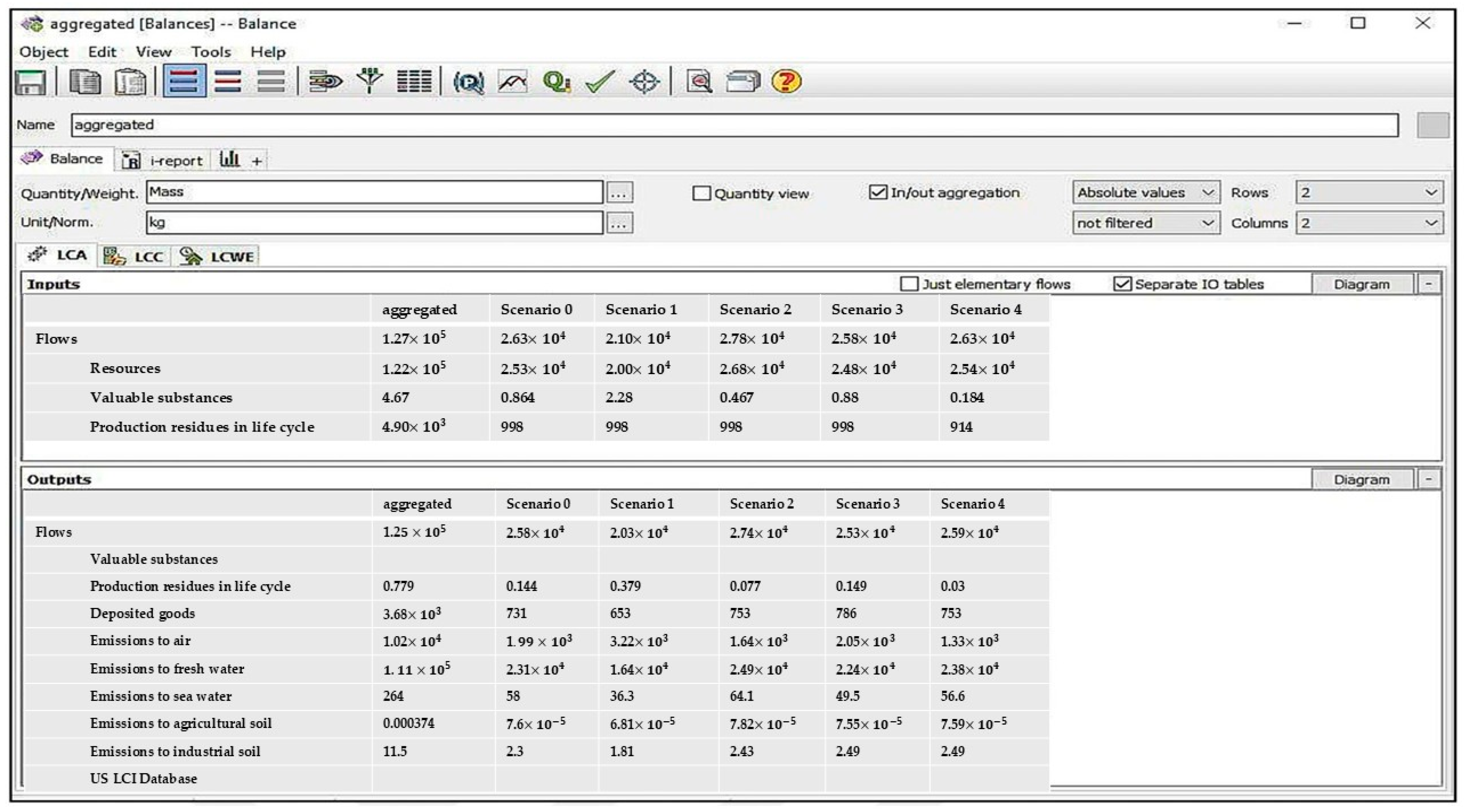
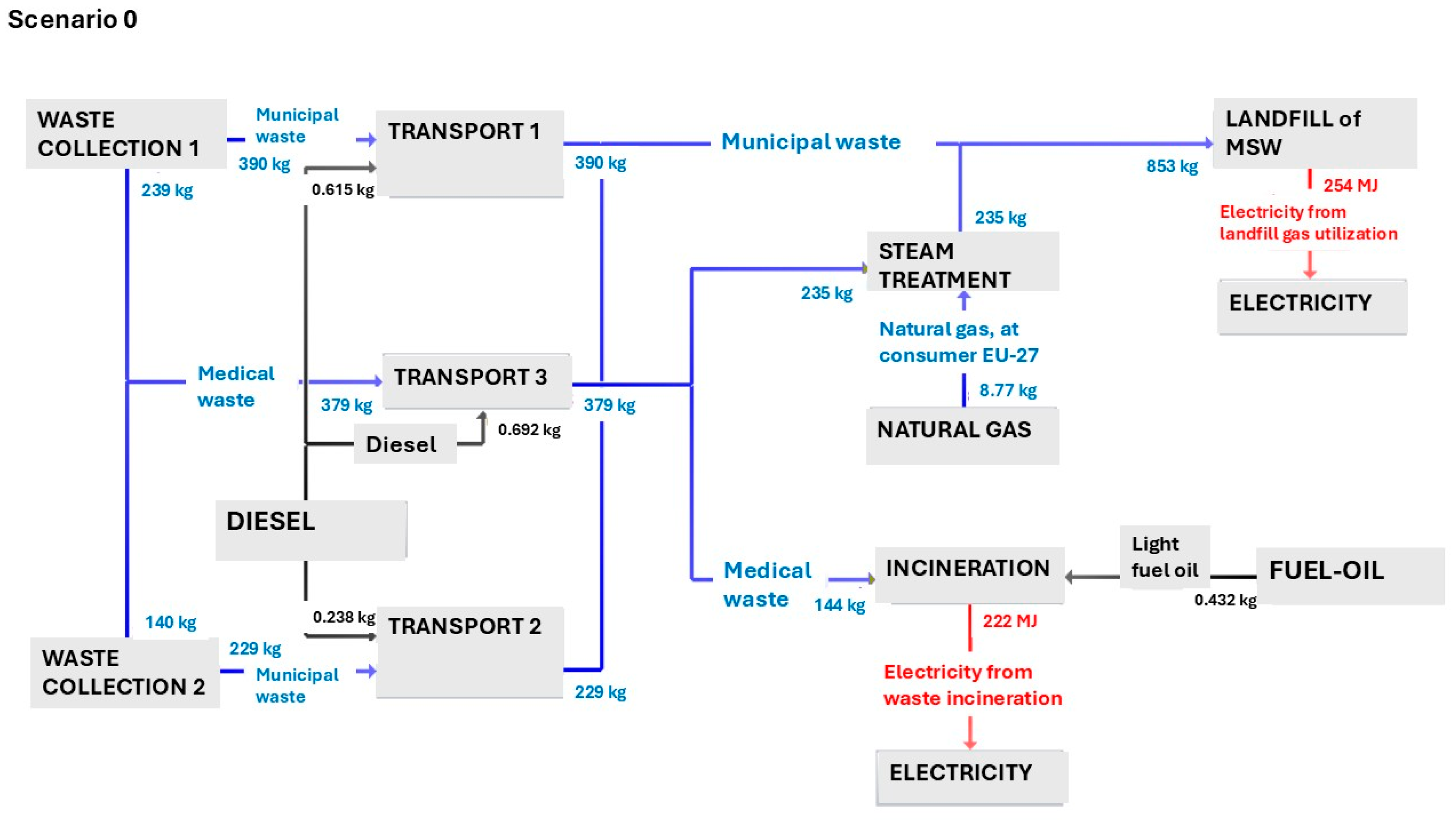
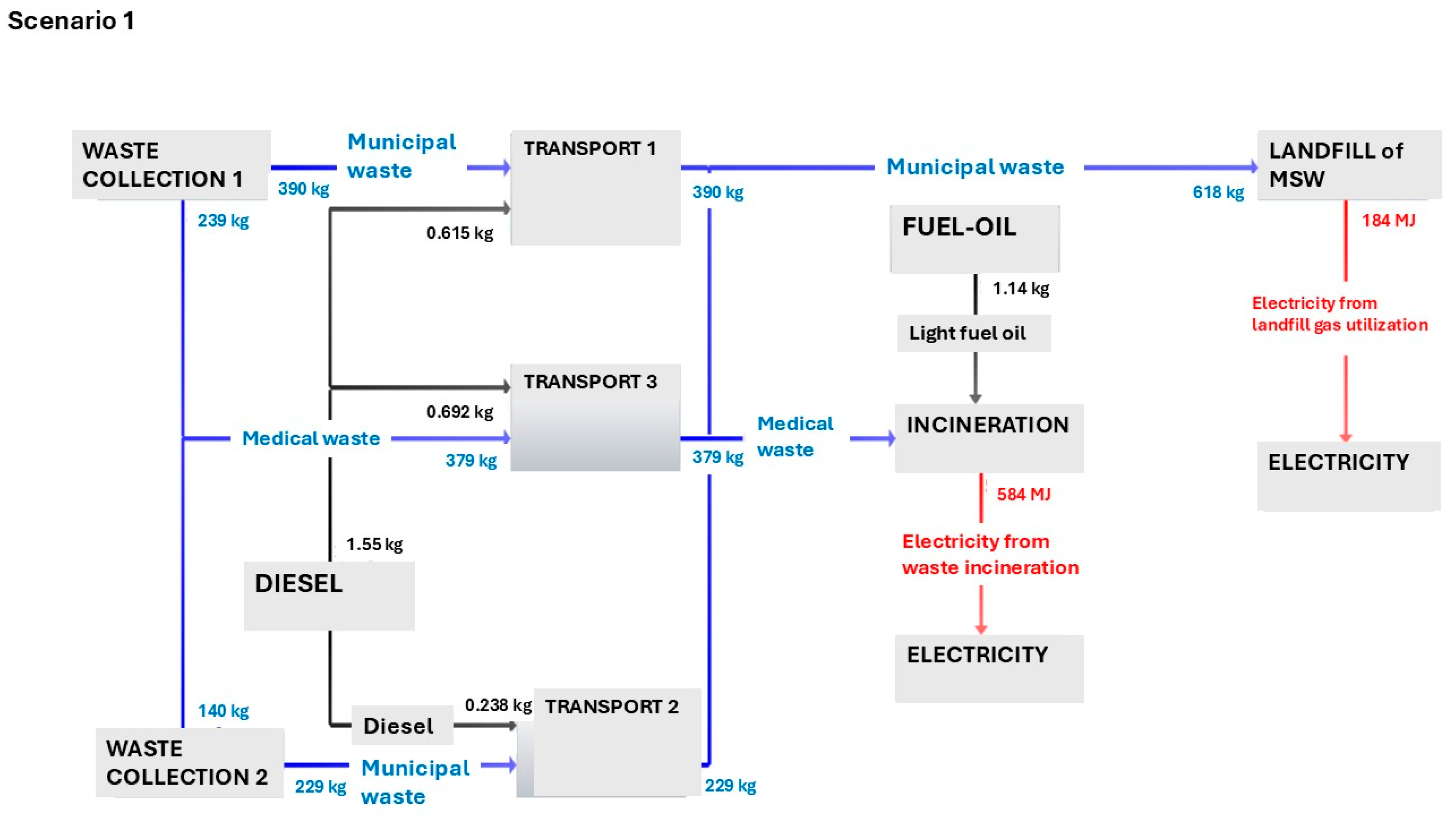
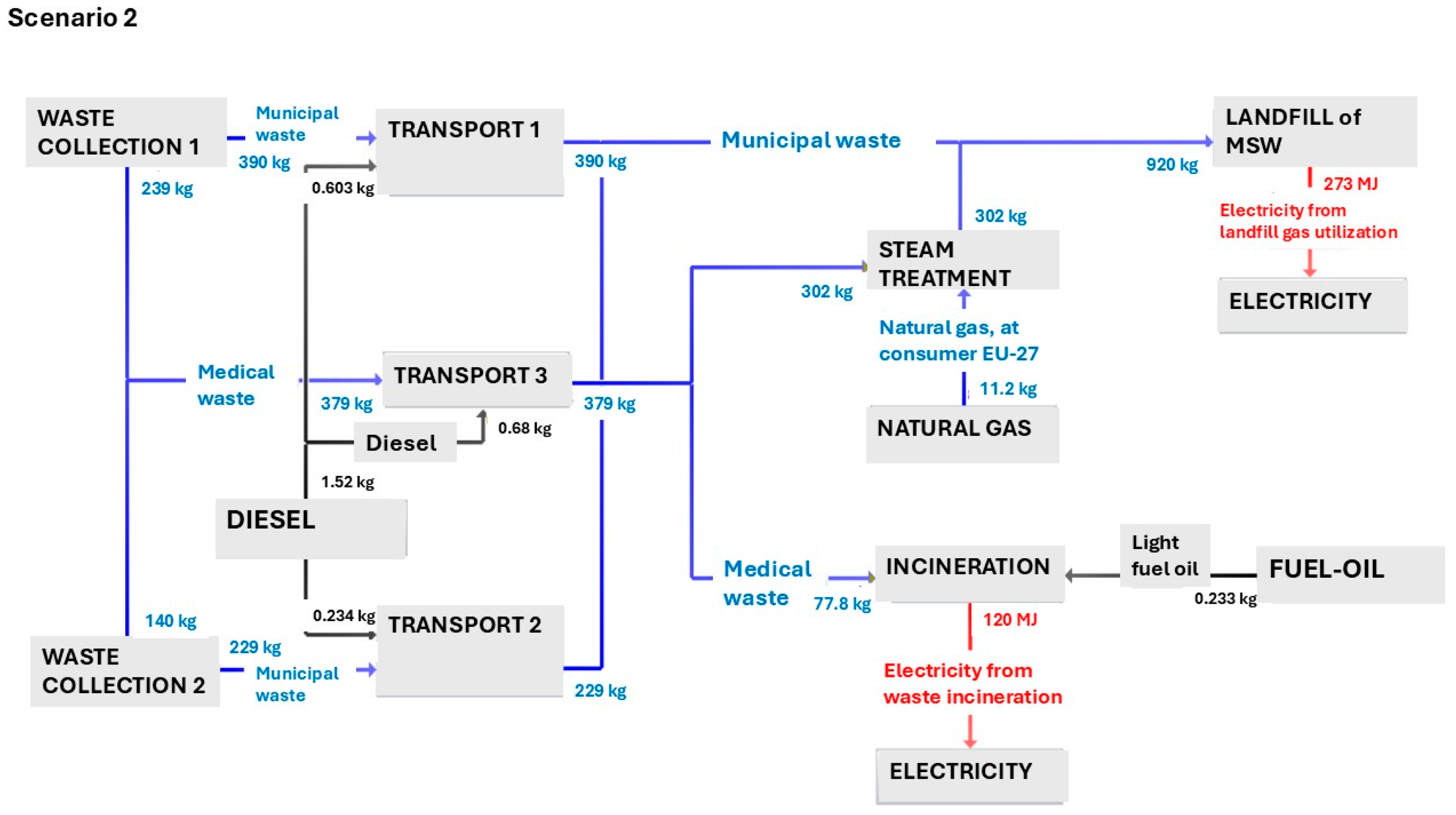

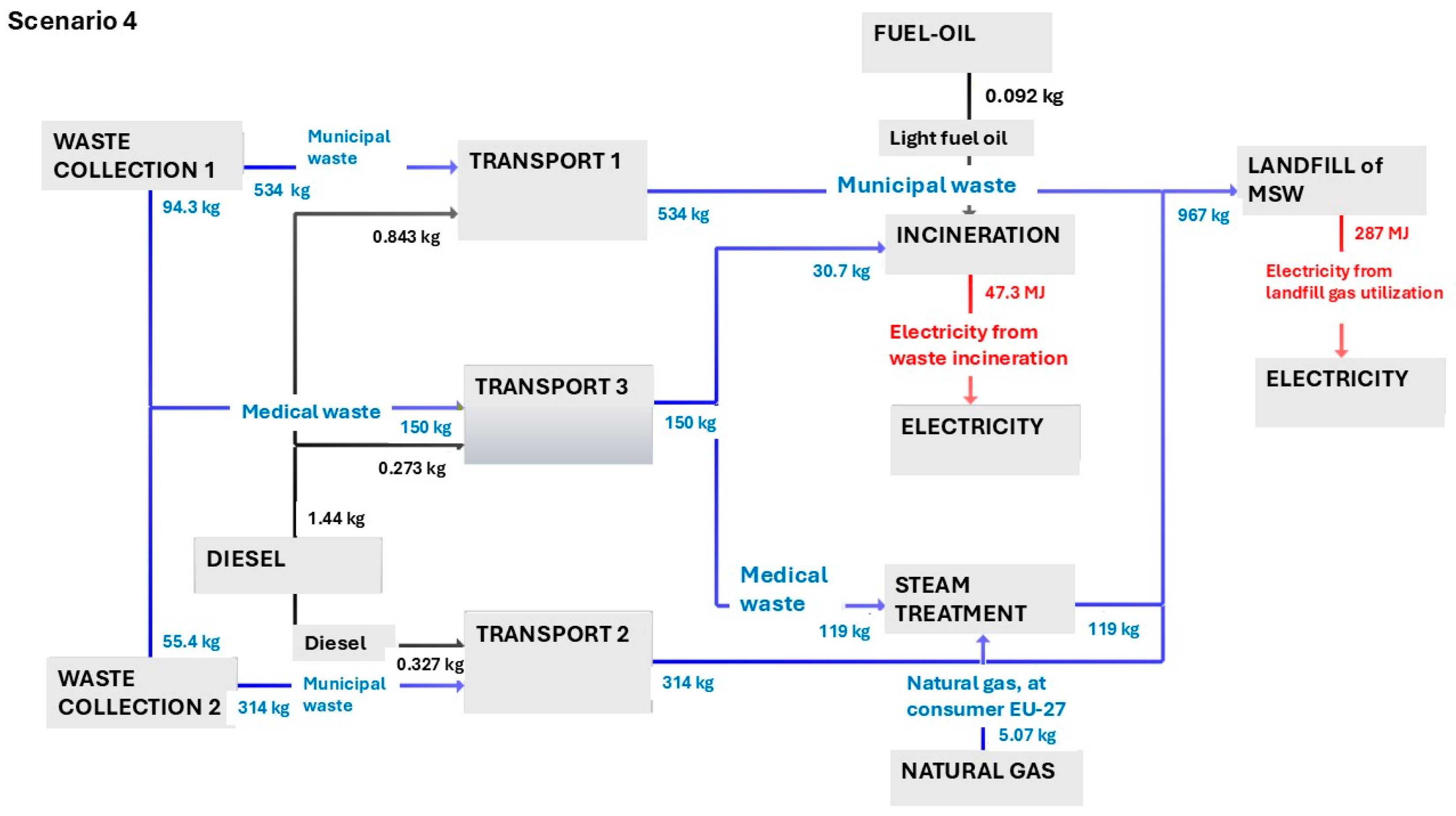
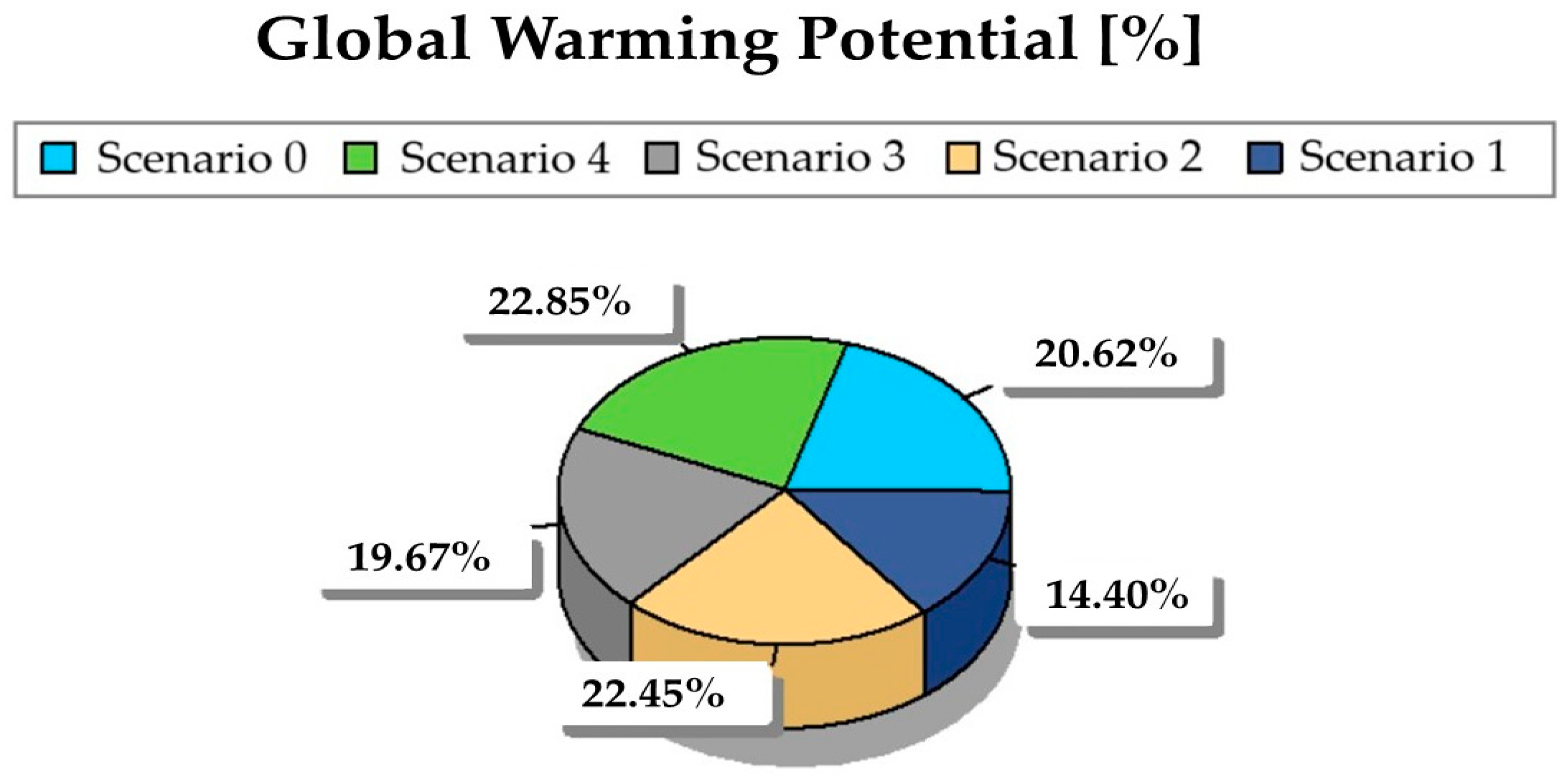
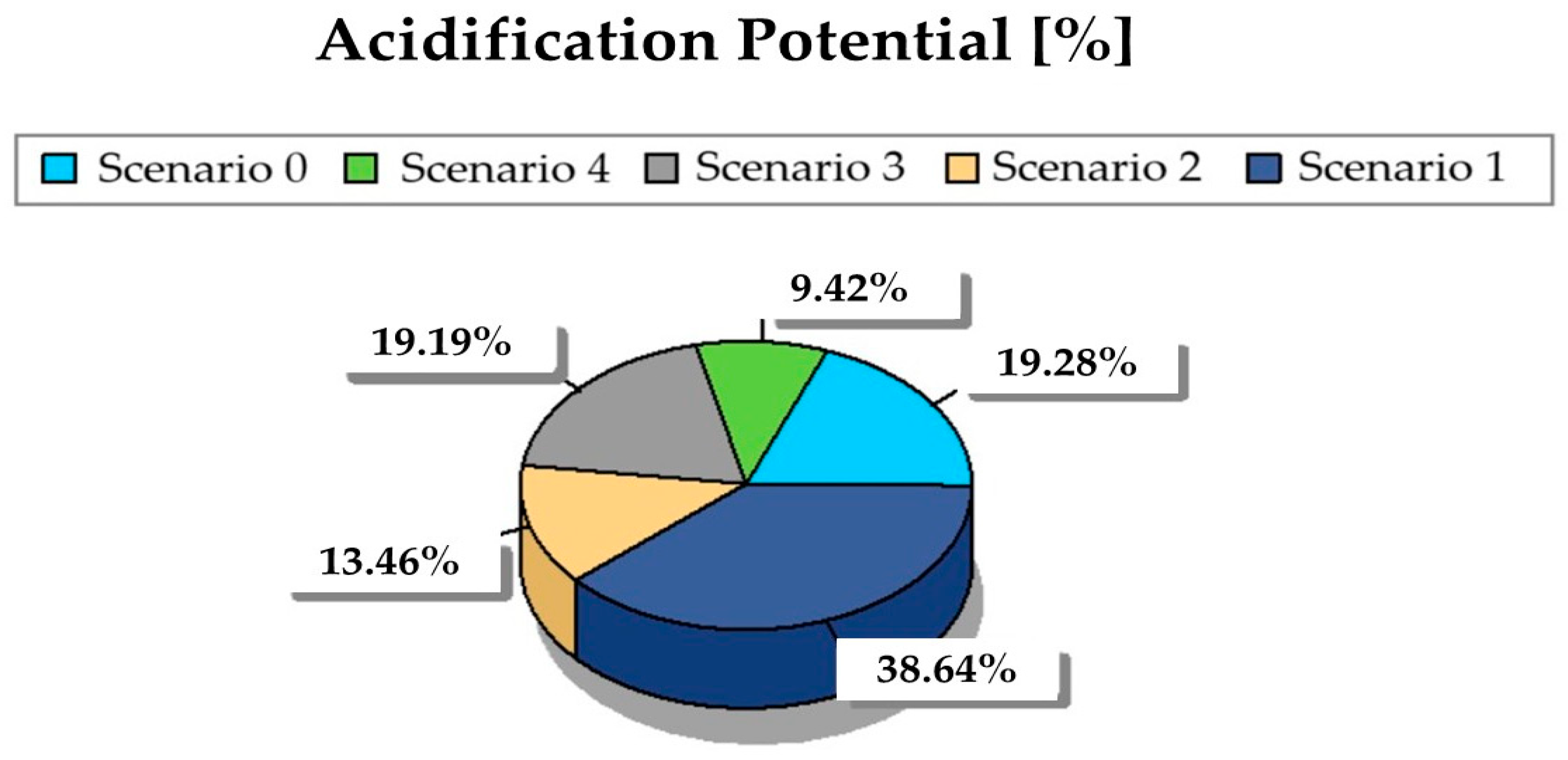
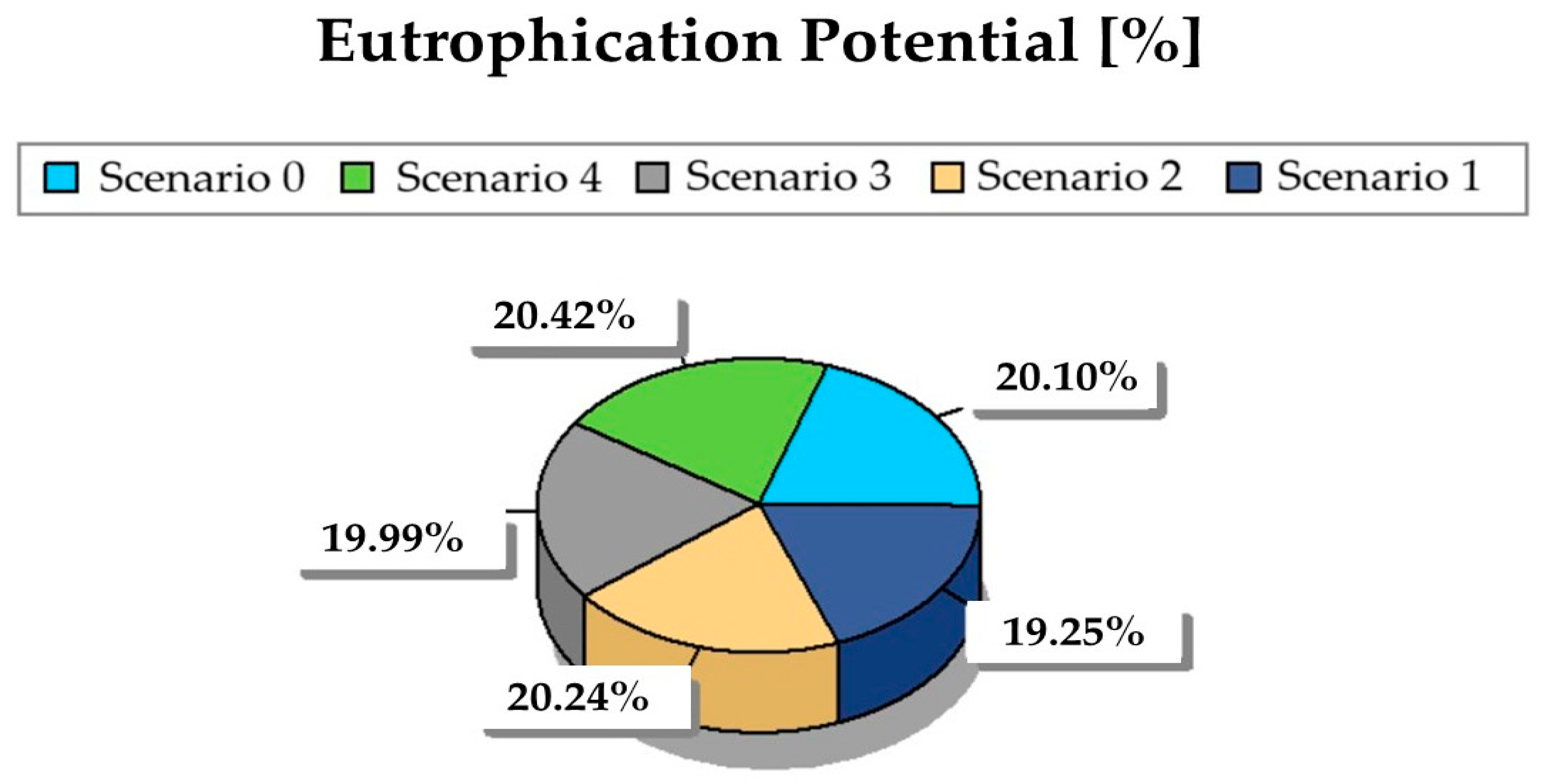

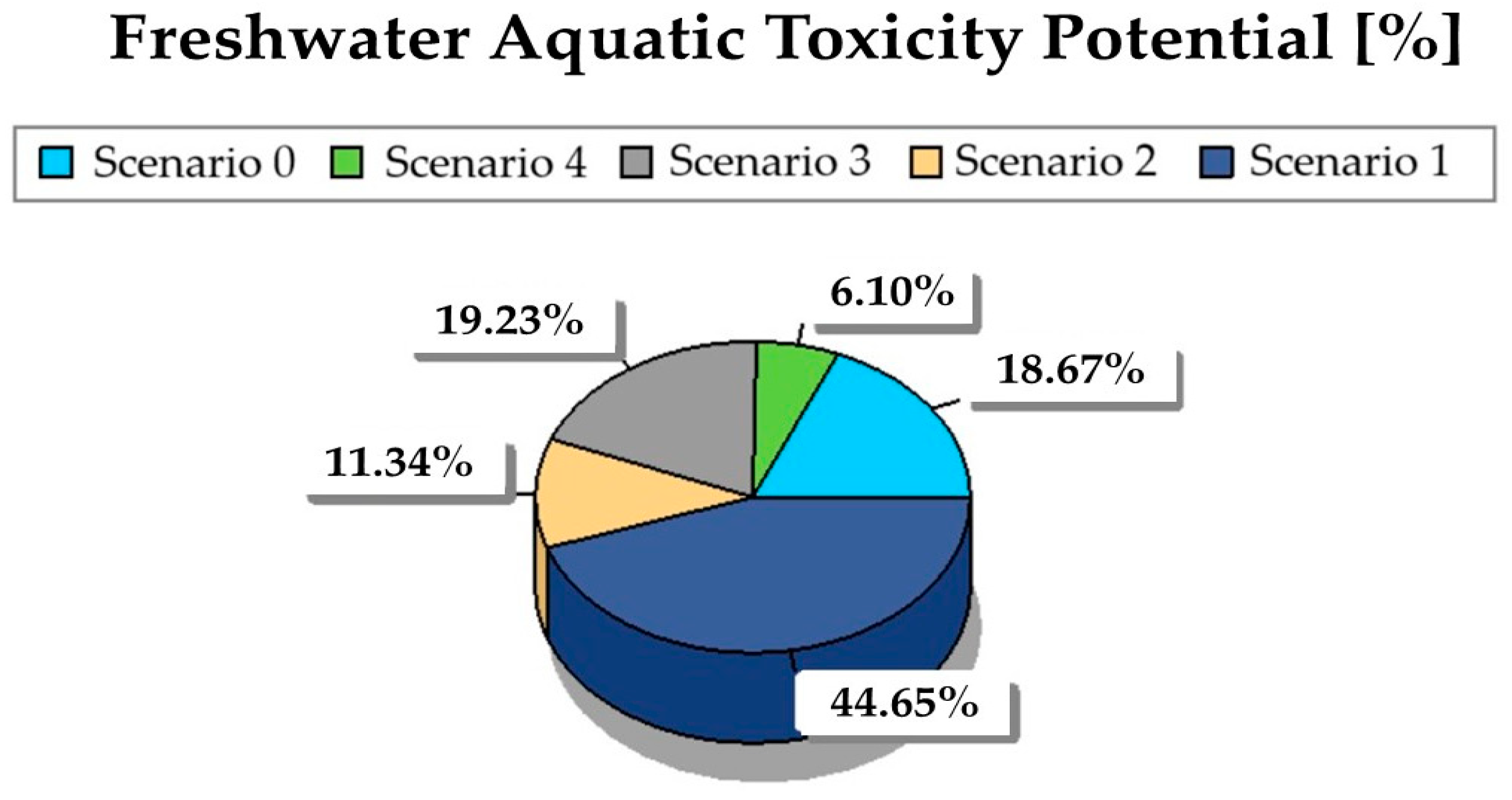
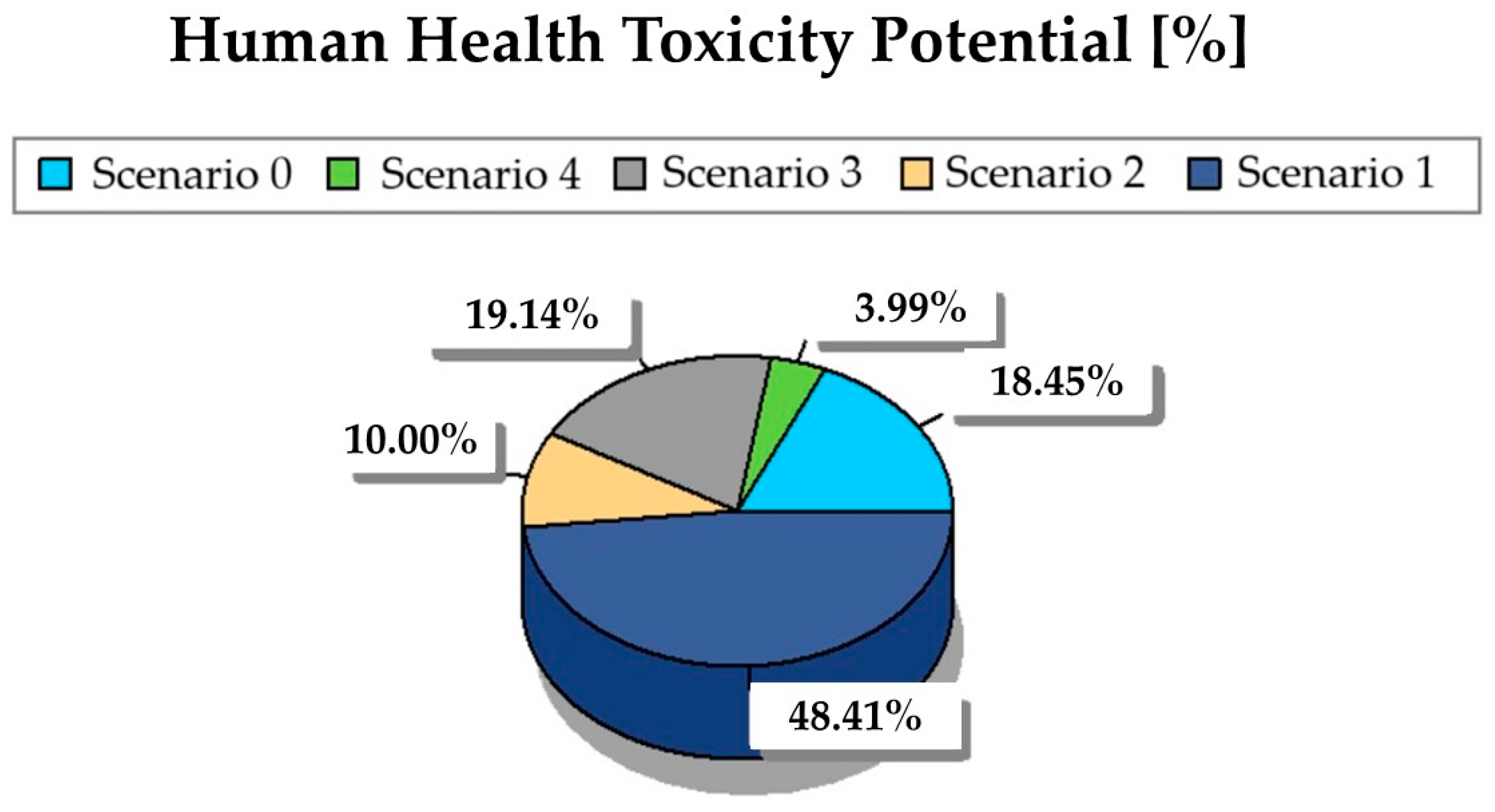
| Scenario 0 | Scenario 1 | Scenario 2 | Scenario 3 | Scenario 4 | |
|---|---|---|---|---|---|
| Global warming [kg CO2-Eq.] | 728.64 | 509.03 | 793.52 | 695.21 | 807.56 |
| Acidification [kg SO2-Eq] | 0.76 | 1.52 | 0.53 | 0.76 | 0.37 |
| Eutrophication [kg PO4-Eq] | 0.81 | 0.77 | 0.81 | 0.8 | 0.82 |
| Ozone layer depletion [kg R11-Eq] | 2.251 × 10−9 | 1.303 × 10−9 | 2.518 × 10−9 | 1.761 × 10−9 | 2.275 × 10−9 |
| Freshwater aquatic toxicity [kg DCB-Eq] | 4.07 | 9.74 | 2.47 | 4.19 | 1.33 |
| Human toxicity [kg DCB-Eq] | 518.83 | 1361.16 | 281.17 | 538.19 | 112.31 |
| Environmental Impact Category | Impact Value | ||||
|---|---|---|---|---|---|
| Scenario 0 | Scenario 1 | Scenario 2 | Scenario 3 | Scenario 4 | |
| Global Warming | 20.62 | 14.4 | 22.45 | 19.67 | 22.85 |
| Acidification | 19.28 | 38.64 | 13.46 | 19.19 | 9.42 |
| Eutrophication | 20.1 | 19.25 | 20.24 | 19.99 | 20.42 |
| Ozone Layer Depletion | 22.27 | 12.89 | 24.91 | 17.42 | 22.51 |
| Freshwater Aquatic Toxicity | 18.67 | 44.65 | 11.34 | 19.23 | 6.1 |
| Human Health Toxicity | 18.45 | 48.41 | 10 | 19.14 | 3.99 |
| Total Impact Value | 119.39 | 178.324 | 102.4 | 114.64 | 85.29 |
| Impact Ratio (%) | 19.89 | 29.79 | 17.06 | 19.10 | 14.21 |
Disclaimer/Publisher’s Note: The statements, opinions and data contained in all publications are solely those of the individual author(s) and contributor(s) and not of MDPI and/or the editor(s). MDPI and/or the editor(s) disclaim responsibility for any injury to people or property resulting from any ideas, methods, instructions or products referred to in the content. |
© 2025 by the authors. Licensee MDPI, Basel, Switzerland. This article is an open access article distributed under the terms and conditions of the Creative Commons Attribution (CC BY) license (https://creativecommons.org/licenses/by/4.0/).
Share and Cite
Çetin, E.; Esenlikçi Yıldız, İ.A.; Öz Yaşar, Ç.; Yulistyorini, A. Life Cycle Assessment of Medical Waste Management: Case Study for Istanbul. Appl. Sci. 2025, 15, 4439. https://doi.org/10.3390/app15084439
Çetin E, Esenlikçi Yıldız İA, Öz Yaşar Ç, Yulistyorini A. Life Cycle Assessment of Medical Waste Management: Case Study for Istanbul. Applied Sciences. 2025; 15(8):4439. https://doi.org/10.3390/app15084439
Chicago/Turabian StyleÇetin, Ender, İlknur Aysel Esenlikçi Yıldız, Çiğdem Öz Yaşar, and Anie Yulistyorini. 2025. "Life Cycle Assessment of Medical Waste Management: Case Study for Istanbul" Applied Sciences 15, no. 8: 4439. https://doi.org/10.3390/app15084439
APA StyleÇetin, E., Esenlikçi Yıldız, İ. A., Öz Yaşar, Ç., & Yulistyorini, A. (2025). Life Cycle Assessment of Medical Waste Management: Case Study for Istanbul. Applied Sciences, 15(8), 4439. https://doi.org/10.3390/app15084439






